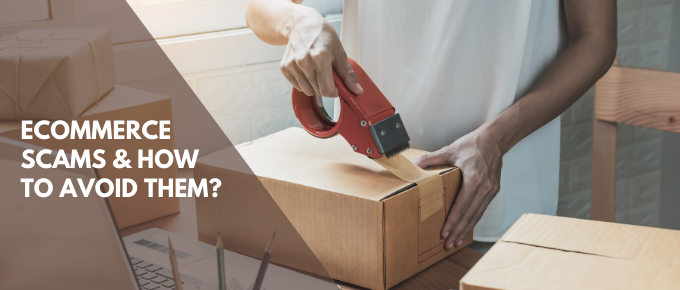
Internet access and adoption are increasing globally at a very fast rate and eCommerce continues to gain more and more attention. However, the $4.28 trillion worth industry has been and continues to be hit with several scams.
Scams on eCommerce platforms result in both merchants and customers losing hard-earned money. There are different forms of eCommerce scams and avoiding them must be a priority for any well-meaning business.
This is important and to get you on the way, here are seven eCommerce scams and how to avoid them.
eCommerce Scams & How To Avoid Them
1. Card Testing
Payment Card Testing is a technique scammers use to validate stolen or computer-generated card information. The stolen cards are usually old so the scammers use card testing to see if they have expired, been reported to banks, or are still valid.
Usually, they target eCommerce sites that offer inexpensive products. The intention here isn’t to purchase the product but just to confirm the card.
Hence, if the card works, they’ll only spend a few dollars on testing. Also, if the amount is large, it may alert the original card owner who can then block the card.
Photo by TheDigitalWay via Pixabay
From the automated response on the eCommerce website, the scammer will know if the card is valuable. If it works, then they can make larger transactions on other websites. Also, they can sell the cards on the dark web to other scammers.
Card testing, aside from being a fraudulent activity, has several negative effects on your eCommerce store. Most card testers use bots to automate the process since they can test many cards manually.
This influx of bot traffic can consume a lot of system resources and network bandwidth. Also, you’ll get many requests for refunds from the original card owners when they realize their cards were used on your website.
How To Avoid The Card Testing Scam
There are a couple of security measures you can take to prevent your eCommerce website from card testing fraud. First of all, you should set daily card limits for IPs. That way, the system will flag anyone trying to test many cards from their computer.
Since most card testers use bots, you should employ strong anti-bot tools. These tools will prevent any automatic script from submitting transactions. CAPTCHA tools are a good example.
Furthermore, if a card has multiple failed or declined transactions, block the IP address and suspend the customer’s account if applicable.
To maintain your business credibility, you should try to cancel the card testing orders and refund the original card owners as soon as possible.
2. Credit/Debit Card Scam
This is a scam that affects both businesses and individuals. It’s just like card testing except that this time, the scammer is making an actual purchase on the eCommerce website and not just testing the card.
Simply put, a credit or debit card scam is the unauthorized use of a credit and debit card to make purchases. It’s the most common type of eCommerce scam with millions of reports every year. scammers either obtain lost or stolen credit cards.
Photo by Karolina Grabowska via Pexels
However, when it comes to eCommerce, they don’t need to get a hold of the card; they just need the card information. eCommerce websites that don’t require OTP or another type of bank verification in processing transactions are usually the target.
Usually, the scammer will purchase a very expensive product since they know the original owner can block the card afterward. Also, they normally spend it on products they can receive quickly.
How To Avoid Credit/Debit Card Scam
Preventing credit/debit card scams is more a job of the card owner. Making sure you don’t misplace your card or leave it exposed when out is important. Also, ensure that your old cards are destroyed before disposing of them.
Scammers also obtain card information online by deceiving victims or hacking. Hence, you should avoid sending pictures of your credit or debit card to anyone on the internet. Also, keep your phones and computers up to date.
On the part of the eCommerce website, you should employ payment channels that require OTP or some other one-time verification before completing transactions. While the scammer may get a hold of the credit card, it’s very unlikely that they’ll have the victim’s phone too.
If the payment system requests for an OTP and they can’t provide it, they’ll have to abandon the transaction. As an eCommerce website owner, you should investigate such abandoned transactions. You should report them immediately if you confirm they’re credit card scams.
3. Overpayment Scam
This is a type of scam whereby the scammer overpays for a product and then asks for a refund. However, the scammer will ask the eCommerce website to refund the money to a different account. This scam also involves credit and debit cards.
If a scammer gets hold of a credit card, they can use it to purchase a product on an eCommerce website. If, for example, the product costs $100, they can pay as much as $500 for it. After making the overpayment, they’ll notify the eCommerce merchant.
Photo by Karolina Grabowska via Pexels
After complaining of paying more than they should, they request a refund of the extra $400. However, they’ll complain that the account used in making the first payment is having an issue or the card is blocked. Then, they’ll provide a different account for the refund.
In an overpayment scam, the scammer isn’t interested in the product or the amount they pay for it. It’s like a way of transferring money from the original victim’s account to that of the scammer.
Sometimes, the scammers don’t make any overpayment. They simply claim that they made payment via a supported service like PayPal. Then, they send a fake receipt to the eCommerce merchant and claim that the money is being held.
How To Avoid Overpayment Scam
As an eCommerce merchant, you should never forward the money on a customer’s request. Apart from the fact that it might be a scammer, forwarding money to a different account is money laundering which is a crime.
If a customer complains of making an overpayment, thoroughly investigate to be sure that it’s true. If it is, simply make a refund and not forward the money to a different account.
The refund should be a reverse transaction to the same account where the initial transaction was made. Furthermore, use a secure payment processor and configure your checkout system to avoid overpayments.
Customers should only be able to pay the exact cost of products and their shipping fees.
4. Phishing Scam
Phishing is an online scam that’s prevalent in different industries; the eCommerce industry is no exception. Scammers typically contact eCommerce customers and merchants and pose as an official from the eCommerce business or a reputable company respectively.
Photo by Mikhail Nilov via Pexels
The scammer then asks the victim for personal information such as account numbers and passwords. These fake emails are designed and composed in a way that it’s very difficult to tell that they’re not authentic.
Another method of phishing is fake checkout pages. A scammer can design a fake checkout page and add it to an eCommerce site. They usually add it as adverts with malicious JavaScript snippets.
When a customer clicks on it, they’re redirected to the fake website. If the customer doesn’t pay attention to the address bar after landing on the fake checkout site, they may not realize they are on a different site and give the scammer their credit card credentials.
Scammers usually use URLs that are very similar to the original URL so it takes extra vigilance to notice the difference.
How To Avoid Phishing Scam
Phishing is one of the easiest scams to commit on the internet. As a result, it cannot be entirely avoided. eCommerce websites must, however, take care to avoid these scams and have policies in place in case it happens.
Since most phishing is done via email, you can protect your eCommerce business against this scam by using secure email services and filters. Email filters can help detect and redirect phishing emails to scam.
Whenever you receive an email, examine the sender, check to be sure that the name of the sender and company is authentic.
Also, encourage your customers to avoid emails from anyone claiming to be a representative of your company and asking them to share their private details. Furthermore, you cannot skip cybersecurity. Make sure you have staunch and up-to-date security protocols in place to prevent malicious code injection.
Your checkout pages should be secure and unique so that your customers can easily identify a fake one. You should also employ multi-factor authentication processes for payment.
5. Merchant Scam
This is a popular eCommerce scam. Just as there are thousands of legitimate online stores, there are also thousands of fake online stores. Scammers either create fake versions of renowned eCommerce stores or simply create a unique, but fake, store.
Photo by Mikhail Nilov via Pexels
To entice customers, they’ll put up expensive products like jewelry, clothes, and shoes, at very cheap rates. When customers place an order and make the purchase, they’ll never receive any product. In some cases, the scammer will send you the product but it’ll be fake.
After scamming many people, the scammer deletes the store from the internet. Aside from setting up eCommerce websites, scammers can also set up selling stores on social media platforms like Facebook and Instagram and advertise fake products at cheap rates.
How To Avoid Merchant Scam
As an eCommerce buyer, you have to ensure that any online store or merchant you’re patronizing is authentic. You can search for reviews on credible platforms and forums and verify where the products are coming from.
Most people fall victim to the merchant scam due to greediness. Websites that sell popular products at unbelievably low rates cannot be trusted. If the rates are too good to be true, don’t make any payment.
Another red flag is if the merchant is using unpopular means of payment like wire transfer, international transfer, preloaded card, money order, or cryptocurrency. Furthermore, if you’re purchasing a very expensive item, don’t agree to make an advance payment.
Upcoming eCommerce startups are the ones that suffer the most from this type of scam. This is because it becomes increasingly difficult for customers to trust them. Hence, as an eCommerce merchant, you should make your business appear original.
You should have detailed information on your privacy policy, refund policy, terms and conditions, and contact. If you’re a popular eCommerce merchant, you should be on the lookout for stores impersonating your brand and business.
Finally, make use of popular and secure payment gateways like card systems, PayPal, and Stripe. Customers have to trust you to do business with you.
6. Chargeback Scam
A chargeback scam involves a scammer paying for an order and then canceling it after receiving the goods. A chargeback is a reverse transaction from a bank account or credit card.
If a customer pays for a product and you put it out for delivery, it can be difficult to stop the delivery halfway especially when you use third-party services.
However, a customer can call their card issuer and complain of an unauthorized transaction and the issuer can cancel and reverse the transaction.
This is what happens in a chargeback scam. The scammer gets his money back and also the product he ordered. This scam is quite common and for a merchant, it can be difficult to know which chargeback claim is authentic.
Photo by Kindel Media via Pexels
Another method scammers use is paying for and receiving a product and then laying complaints that they didn’t receive it. Such cases of missing packages are very common in the eCommerce industry.
Hence, the merchant may be forced to either refund the payment amount or send a replacement product. Whichever one, it’s a win for the scammer.
If you’re an eCommerce that sells digital products, you’ll deal with more chargeback scams. This is because it can be very difficult to prove that the customer received the product.
How To Avoid Chargeback Fraud
To avoid chargeback fraud, you must properly log all deliveries. Ensure that the address the package is en route to is the address of the receiver.
Before giving out the product, the receiver should show a valid ID to confirm the name and address that placed the order. Also, they should have to sign to consent that they got the product. With this, it’s very difficult for any scammer to claim a chargeback.
Furthermore, try to make deliveries prompt. Scammers mainly leverage on deliveries that take days. They can wait a day or two to be sure the product is far from the pick-up point before requesting reversal from their card issuer.
7. Triangulation Scam
The triangulation scam is highly anonymous. You may never know you’re a victim. The scam involves a scammer buying a product on behalf of a real customer and stealing their private details in the process.
Here the scammer acts as a middle man. This type of scam mainly happens on marketplaces like Amazon, eBay, etc. A scammer can, for example, set up a seller account on these marketplaces without having any actual products.
Photo by Energepic.com via Pexels
When customers place orders, they purchase the product from another seller and send it to the customer; it’s just like dropshipping. While the customer gets the products they paid for, the scammer gets the customer’s payment information.
The customer won’t suspect a thing since they got their products. They’ll only be aware of the scam when the scammer makes an unauthorized payment with their card details.
Another method of triangulation scam involves the scammer purchasing products with a stolen card and then sending the product to the customer.
Hence, if authorities were to trace the card, they’ll trace it to the innocent customer. On the other hand, if the owner of the stolen card reports and makes a chargeback request, the merchant will have to refund them and be at a loss.
How To Avoid Triangulation Scam
Triangulation fraud is just a smart way for fraudsters to use stolen credit cards to make purchases. It’s worth noting that many of the tools and techniques used to prevent regular credit card fraud also protect merchants from triangulation fraud.
As an eCommerce business owner, you’ll need secure fraud protection software to help detect triangulation scams. What’s most important is that the card details match the details of the customer placing the order.
Nevertheless, a triangulation scam can take several forms. Although scammers strive to have clean transactions, some symptoms are unavoidable. For example, if you see a significant rise in orders for a popular product, you should check to be sure it’s not due to a triangulation scam.
Furthermore, search your products on eBay, Amazon, and social media marketplaces. If you notice your products being resold there for unreasonably cheap rates, the vendor may be a scammer.
Bottom Line
In avoiding eCommerce scams, the basic thing to do is be vigilant. Scammers mainly succeed because their victims are not vigilant enough to detect the illegitimacy in their scams.
The seven eCommerce scams listed above are quite common. With the help of this article, you’ll be able to protect yourself from these scams, whether as an eCommerce buyer or merchant.













